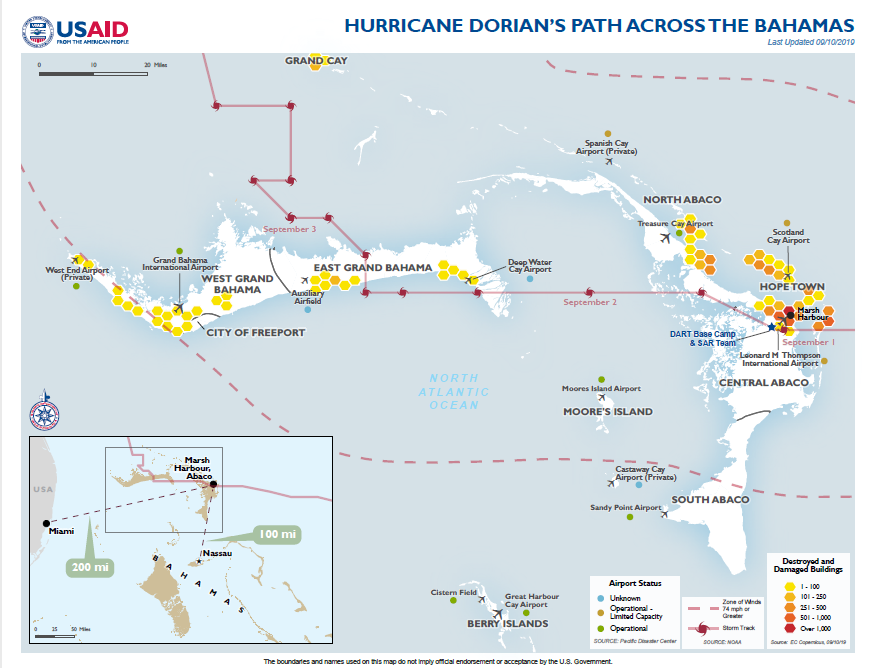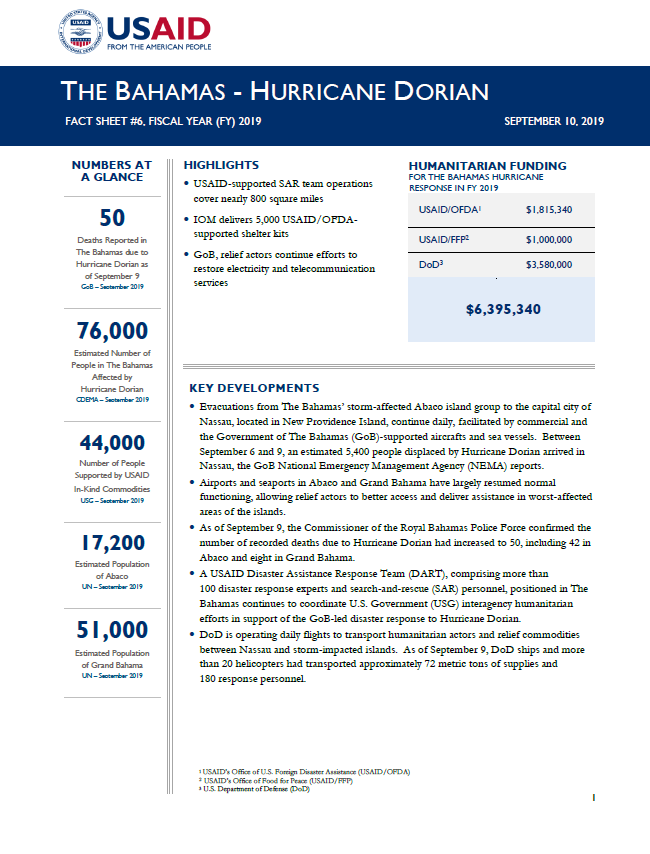- What We Do
- Agriculture and Food Security
- Democracy, Human Rights and Governance
- Economic Growth and Trade
- Education
- Environment and Global Climate Change
- Gender Equality and Women's Empowerment
- Global Health
- Humanitarian Assistance
- Transformation at USAID
- Water and Sanitation
- Working in Crises and Conflict
- U.S. Global Development Lab
Speeches Shim
September 10, 2019
Highlights
USAID-supported SAR team operations cover nearly 800 square miles
IOM delivers 5,000 USAID/OFDA-supported shelter kits
GoB, relief actors continue efforts to restore electricity and telecommunication services
The Bahamas - Hurricane Dorian Map #6, (FY) 2019 ![]() (pdf - 684k)
(pdf - 684k)
Numbers At A Glance
50
76,000
44,000
17,200
51,000
Humanitarian Funding
FOR THE BAHAMAS HURRICANE RESPONSE IN FY 2019
| USAID/OFDA | $1,815,340 |
| USAID/FFP | $1,000,000 |
| TOTAL | $6,395,340 |
Key Developments
Evacuations from The Bahamas’ storm-affected Abaco island group to the capital city of Nassau, located in New Providence Island, continue daily, facilitated by commercial and the Government of The Bahamas (GoB)-supported aircrafts and sea vessels. Between September 6 and 9, an estimated 5,400 people displaced by Hurricane Dorian arrived in Nassau, the GoB National Emergency Management Agency (NEMA) reports.
Airports and seaports in Abaco and Grand Bahama have largely resumed normal functioning, allowing relief actors to better access and deliver assistance in worst-affected areas of the islands.
As of September 9, the Commissioner of the Royal Bahamas Police Force confirmed the number of recorded deaths due to Hurricane Dorian had increased to 50, including 42 in Abaco and eight in Grand Bahama.
A USAID Disaster Assistance Response Team (DART), comprising more than 100 disaster response experts and search-and-rescue (SAR) personnel, positioned in The Bahamas continues to coordinate U.S. Government (USG) interagency humanitarian efforts in support of the GoB-led disaster response to Hurricane Dorian.
DoD is operating daily flights to transport humanitarian actors and relief commodities between Nassau and storm-impacted islands. As of September 9, DoD ships and more than 20 helicopters had transported approximately 72 metric tons of supplies and 180 response personnel.
CURRENT SITUATION
More than 600 people from Abaco and surrounding cays arrived to Nassau on September 9 according to NEMA. The new arrivals are in addition to approximately 4,800 evacuees who arrived from the island group to Nassau between September 6 and 8. More than1,900 people are spread across eight collective centers as of September 10, and NEMA notes that additional cots are urgently required to supplement shelter capacity.
Following the displacement from Abaco, an estimated 4,000 people remain in Abaco and surrounding cays, the Caribbean Disaster Emergency Management Agency (CDEMA) reports. The fluid population movements, particularly from Abaco, have required response actors to conduct regular assessments to determine the location and extent of unmet needs of affected communities in Abaco. According to NEMA, temporary shelter assistance, as well as SAR and debris clearance operations, remain immediate priorities.
As of September 10, airports and seaports in Abaco and Grand Bahama have largely resumed normal functioning and localized debris removal efforts have cleared some roads, reducing obstacles for relief actors and affected communities, according to the UN. However, the port in eastern Grand Bahama remains non-functional, while some airports in Abaco—including the Leonard M. Thompson International Airport in Marsh Harbour town, as well as smaller airports in Spanish Cay and Scotland Cay—have limited capacity to manage increased air traffic owing to the large humanitarian air operations underway.
After conducting an interagency assessment mission on September 8, the International Organization for Migration (IOM) reports extensive destruction in two Marsh Harbour communities—Pigeon Pea and The Mudd—which hosted an estimated 70 percent of the island’s total informal housing and a large Haitian migrant population.
NATIONAL AND INTERNATIONAL RESPONSE
Emergency telecommunications partners—including the UN World Food Program (WFP), Télécoms Sans Frontières (TSF), Ericsson Response, the Vodafone Foundation, and private sector companies—are supporting temporary satellite connectivity in four Marsh Harbour sites supporting humanitarian operations, including the international airport, where USAID personnel have established operational bases. WFP is also supporting satellite connectivity in Grand Bahama. In addition, by September 9, TSF had activated free humanitarian calling operations for communities in Abaco who had been unable to access communication services in the wake of Hurricane Dorian, and the organization continues to survey the island group to connect people in remote locations to communication services.
The GoB Water and Sewerage Corporation (WSC) continues to conduct electrical repairs of and clear roads to water pumping stations and well fields in Marsh Harbour; by September 9, the WSC had re-activated six pumping stations and commenced water quality testing. Lack of power in the area, however, will continue to stall the resumption of water distribution. On September 9, Mercy Corps coordinated the delivery of 1 million gallons of water, as well as three water treatment units, to Grand Bahama’s Freeport town to increase access to safe drinking water for affected populations in the area.
Since September 5, Adventist Development and Relief Agency (ADRA) reports reaching 400 people per day with hot meals in Grand Bahama. Other food distributions in affected areas of Abaco and Grand Bahama also continue, coordinated by NEMA and supported by several actors including WFP, local and international non-governmental organizations (NGOs), and other public and private entities.
IOM began distributing 1,000 pieces of tarpaulin, intended to repair damaged roofs, in Marsh Harbour on September 9; the UN agency also plans to initiate its Displacement Tracking Matrix to support tracking of population movements and identification of shelter needs across affected areas.
The GoB Ministry of Environment is scheduled to commence a six-week assessment mission in Abaco on September 10 to examine hazardous material risks, the UN reports.
USG RESPONSE
DoD continues to provide extensive logistic support for humanitarian operations, with U.S. Northern Command (NORTHCOM) operating daily flights for NGO, UN, and DART staff, as well as humanitarian supplies, from Nassau to affected areas of Abaco and Grand Bahama. On September 10, NORTHCOM helicopters supported the movement of International Medical Corps emergency medical team staff and medical supplies, as well as a joint assessment team—comprising staff from UN Office for the Coordination of Humanitarian Affairs (OCHA) and UK Department for International Development (DFID)—to Freeport. On the same day, NORTHCOM facilitated a health assessment by staff from the GoB and the Pan American Health Organization in northern Abaco’s Cooper’s Town.
Also on September 10, DART shelter specialists assessed two collective shelters in Nassau managed by the GoB Ministry of Social Services. While officials indicate the shelters are at capacity, residents’ immediate needs are largely being met. The DART continues to work with GoB authorities, including the Ministry of Public Works, and other relief actors to explore options for immediate and longer-term solutions for displaced households.
On September 9, technical experts from the DART and WSC traveled to Grand Cay—a district in the northern Abaco island chain—and Sweetings Cay—located in eastern Grand Bahama Island—on a DoD helicopter, accompanied by U.S. Coast Guard (USCG) personnel, to assess water, sanitation, and hygiene (WASH) facilities on the islands. In Grand Cay, the team found an estimated 40 percent of the area’s 500 residents had evacuated prior to or after the storm. The remaining 300 residents identified medical support, as well as restoration of electricity and repair of water storage facilities as urgent needs; the latter activities would enable utilization of the area’s undamaged reverse osmosis unit. In Sweetings Cay, an estimated 80 percent of the area’s normal 100 residents had evacuated; remaining residents similarly expressed the need for electricity services, as well as water and shelter support. DART and WSC staff are coordinating with NEMA regarding appropriate response interventions.
By September 9, USAID-supported SAR team operations had covered 776 square miles of land, air, and sea, including more than 250 structural assessments conducted in Marsh Harbour and nearby cays on September 9.
To complement ongoing distributions of USAID plastic sheeting by NEMA in affected areas of Abaco and Grand Bahama, IOM transported 5,000 USAID/OFDA-supported and locally procured shelter kits—containing nails, rope, steel wires, and other materials necessary to erect shelters using the plastic sheeting—from the UN agency’s warehouse in Haiti to Nassau on September 9 and 10. USAID/OFDA is coordinating with NEMA to transport and distribute the shelter kits.
CONTEXT
From September 1 to 2, Hurricane Dorian made landfall over Abaco and Grand Bahama as a Category 5 storm on the Saffir-Simpson Hurricane Wind Scale, bringing sustained winds of approximately 180 miles per hour, heavy rains, and storm surges of up to 23 feet to the islands.
As a result of widespread flooding and destruction to infrastructure caused by Hurricane Dorian, U.S. Chargé d’Affaires Stephanie Bowers declared a disaster in The Bahamas on September 2. In response, USAID/OFDA provided an initial $200,000 to The Bahamas Red Cross Society and rapidly activated a DART and Response Management Team (RMT). USAID/OFDA is also coordinating with the USCG, part of the U.S. Department of Homeland Security; the U.S. Department of Defense; and the GoB to swiftly deliver emergency relief items to populations in The Bahamas most severely affected by the hurricane.
PUBLIC DONATION INFORMATION
The most effective way people can assist relief efforts is by making cash contributions to humanitarian organizations that are conducting relief operations. A list of humanitarian organizations that are accepting cash donations for disaster responses around the world can be found at www.interaction.org.
USAID encourages cash donations because they allow aid professionals to procure the exact items needed (often in the affected region); reduce the burden on scarce resources (such as transportation routes, staff time, and warehouse space); can be transferred very quickly and without transportation costs; support the economy of the disaster-stricken region; and ensure culturally, dietarily, and environmentally appropriate assistance.
More information can be found at: USAID Center for International Disaster Information: www.cidi.org/hurricane-dorian/ or +1.202.661.7710. Information on relief activities of the humanitarian community can be found at http://www.reliefweb.int.



Comment
Make a general inquiry or suggest an improvement.